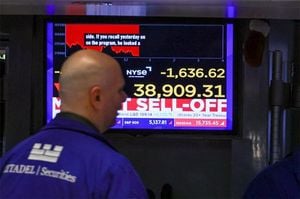Apple shares took a significant hit last week, plummeting 14% and erasing nearly $300 billion in market value following President Donald Trump’s announcement of sweeping new tariffs. The stock finished the week at $188.38 after dropping 9% on April 3 and another 5% on April 4. Investors quickly assessed the implications of the newly imposed tariffs on Apple’s critical manufacturing ecosystem, which heavily relies on imports from China, Vietnam, and India.
The new tariffs, set to take effect on April 9, 2025, impose a staggering 54% rate on Chinese imports, while Vietnam and India face rates of 46% and 26%, respectively. Unlike during Trump’s first term, when Apple managed to secure exemptions for several products, there is no formal process in place for requesting waivers this time, leaving the tech giant in a precarious situation.
Analysts are now warning that Apple faces a tough choice: absorb the tariff costs or pass them on to consumers. If Apple decides to transfer the entire cost burden, iPhone prices could increase by as much as 43%. This would push the base iPhone 16 from $799 to potentially $1,142, while the premium iPhone 16 Pro Max could soar to an eye-watering $2,300.
In a report, Morgan Stanley estimated that these tariffs could cost Apple an additional $33 billion annually, with a potential 26% reduction in earnings per share if the company takes no mitigating actions. Such a hit to the bottom line has understandably raised concerns among investors.
Moreover, moving production to the United States presents its own set of challenges for Apple. Industry experts estimate that assembly costs could jump dramatically; the cost of assembling an iPhone could rise from roughly $30 per phone in China to $300 in the U.S. This tenfold increase would further pressure Apple’s profit margins.
Despite the short-term volatility, many analysts are maintaining a positive outlook on Apple’s long-term growth potential. The company has shown resilience in navigating previous trade tensions, and its focus on international expansion, particularly in emerging markets like India, could help offset potential revenue disruptions due to geopolitical tensions. This diversification strategy may prove crucial in the coming months.
Over the past five years, Apple’s total shareholder returns, including price appreciation and dividends, reached an impressive 189.66%. This strong track record gives many investors confidence despite the recent turbulence. Apple has also been expanding its service offerings, recently integrating CONNEQT Health’s arterial biomarkers into its Health app, which aligns with its broader strategy of leveraging AI advancements for growth.
While this announcement failed to boost short-term share prices, it could support long-term earnings if health services expand. Revenue is projected to grow by approximately 6.5% annually, according to analyst estimates. Furthermore, Apple’s current share price remains approximately 11.6% below the consensus price target of $252.59, indicating potential upside as many analysts view the stock as undervalued relative to its fair value estimates.
The tariff situation remains fluid, with the potential for exemptions or modifications still on the table. Apple has successfully navigated similar challenges in the past. Recently, the Nasdaq entered bear market territory as trade tensions escalated between the U.S. and China, affecting many tech stocks, not just Apple.
In a broader context, the U.S. stock market has experienced a turbulent first quarter of 2025, characterized by increased volatility and negative returns across major indices. Concerns about tariffs, economic data, and the performance of key technology stocks have contributed to this challenging environment for investors. The year began with the revelation of DeepSeek, an AI software developed in China that rivaled its U.S. counterparts, sending shockwaves across global markets.
As reported by Reuters, a global investor sell-off ensued, with one major tech company losing $593 million in a single day. In response, the U.S. government implemented policies aimed at promoting U.S.-listed tech firms while simultaneously attempting to mitigate the impact of DeepSeek. The Federal Reserve announced it would maintain interest rates between 4.25% and 4.50% in the short term, adding to market uncertainty.
In March, President Trump’s announcement of further global tariffs on Europe and China fueled investor concerns, leading to a drop in market indexes not seen since the COVID-19 pandemic. China retaliated with reciprocal tariffs on U.S. goods of 34%, escalating tensions further.
As the Cboe Volatility Index (VIX) currently sits at 29.68%, well above its one-year average of 17.6%, investors are advised to seek stocks that provide steady revenue, dividend growth, and significant cash flows. Systemically important sectors, including energy, real estate, healthcare, finance, and tech, are seen as ideal for investors in this climate.
Venture capitalist Chamath Palihapitiya recently commented on the growing wealth disparity in the U.S., noting that the top 10% of American households own 88% of total equities. He emphasized that the bottom 50% have little to no interest in the stock market, suggesting that traditional stock market bailouts may no longer be politically viable.
As the S&P 500 plunged 6% on April 4, pushing two-day losses past 10%, and the Nasdaq entered bear market territory after falling 22% from its record high, the market faces significant challenges ahead. President Trump has expressed limited concern about market losses, stating, “I don’t want anything to go down, but sometimes you have to take medicine to fix something.”
In light of these developments, investors are left wondering whether Apple can weather the storm and maintain its growth trajectory amid escalating trade tensions and shifting market dynamics. The coming weeks will be critical as Apple navigates these challenges while seeking to leverage its strengths in innovation and global market presence.






